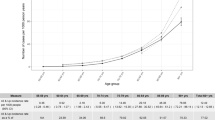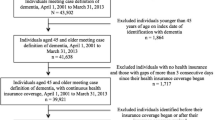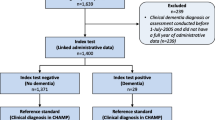Abstract
The fields of neurodegenerative disease and dementia research have grown considerably in the last several decades. Due to tremendous efforts of basic and clinical research scientists, we know a great deal about dementia risk factors and have multiple treatment options. Clinician recognition of cognitive impairment has increased considerably, national policies which support screening for and documenting cognitive dysfunction now exist, and public awareness of neurodegenerative disease has never been greater. These conditions promote (and demand) the growth of translational epidemiology and health services research, which focuses on examining outcomes in groups of individuals as a function of health care experiences. This review discusses the use of administrative data to answer health care outcomes and disparities questions in dementia. Of particular interest are publically available datasets that contain varying amounts of diagnostic, clinical, pharmacy, and patient information. Methodological challenges that are frequently encountered and must be understood to minimize biased inference are also discussed.
Similar content being viewed by others
References
Papers of particular interest, published recently, have been highlighted as: • Of importance
Social Security Administration. 2015.
Willis AW, Schootman M, Kung N, Racette BA. Epidemiology and neuropsychiatric manifestations of Young Onset Parkinson’s Disease in the United States. Parkinsonism Relat Disord. 2013;19:202–6.
Wright WA, Evanoff BA, Lian M, Criswell SR, Racette BA. Geographic and ethnic variation in Parkinson disease: a population-based study of US Medicare beneficiaries. Neuroepidemiology. 2010;34:143–51.
Pope G, Ellis R, Ash A, et al. Diagnostic cost group hierarchical condition category models for Medicare risk adjustment. Final Report. 2015.
Centers for Medicare and Medicaid Services. National Plan and Provider Enumeration System (NPPES). 2014.
Faurot KR, Jonsson FM, Pate V, et al. Using claims data to predict dependency in activities of daily living as a proxy for frailty. Pharmacoepidemiol Drug Saf. 2015;24:59–66. A major difficulty with using non-enriched or basic administrative claims data to examine health care experiences and outcomes in chronic or progressive neurological disease is the inability to access functional data. This reference demonstrates how global and specific disability can be assessed and adjusted for in claims data studies.
Kim DH, Schneeweiss S. Measuring frailty using claims data for pharmacoepidemiologic studies of mortality in older adults: evidence and recommendations. Pharmacoepidemiol Drug Saf. 2014;23:891–901.
Covinsky KE, Hilton J, Lindquist K, Dudley RA. Development and validation of an index to predict activity of daily living dependence in community-dwelling elders. Med Care. 2006;44:149–57.
Taylor Jr DH, Fillenbaum GG, Ezell ME. The accuracy of medicare claims data in identifying Alzheimer’s disease. J Clin Epidemiol. 2002;55:929–37.
Koller D, Bynum JP. Dementia in the USA: state variation in prevalence. J Public Health (Oxf). 2014. This study indirectly hightlights an often understudied issue of “big data” studies- spatial autocorrelation- the tendency of people/physicians/hospitals in the same area to have similar testing/diagnosis/treatment/health behavior patterns. Using national datasets may require adjustment for regional factors such as physician/specialist supply, presence of academic medical centers, or even consideration of neighborhood factors such as safety, walkability, transportation.
Lin PJ, Fillit HM, Cohen JT, Neumann PJ. Potentially avoidable hospitalizations among Medicare beneficiaries with Alzheimer’s disease and related disorders. Alzheimers Dement. 2013;9:30–8.
Daiello LA, Gardner R, Epstein-Lubow G, Butterfield K, Gravenstein S. Association of dementia with early rehospitalization among Medicare beneficiaries. Arch Gerontol Geriatr. 2014;59:162–8.
Givens JL, Mitchell SL, Kuo S, Gozalo P, Mor V, Teno J. Skilled nursing facility admissions of nursing home residents with advanced dementia. J Am Geriatr Soc. 2013;61:1645–50.
Wilcock DM, Gharkholonarehe N, Van Nostrand WE, Davis J, Vitek MP, Colton CA. Amyloid reduction by amyloid-beta vaccination also reduces mouse tau pathology and protects from neuron loss in two mouse models of Alzheimer’s disease. J Neurosci. 2009;29:7957–65.
Besson FL, La JR, Doeuvre L, et al. Cognitive and brain profiles associated with current neuroimaging biomarkers of preclinical Alzheimer’s disease. J Neurosci. 2015;35:10402–11.
Toga AW, Foster I, Kesselman C, et al. Big Biomedical data as the key resource for discovery science. J Am Med Inform Assoc. 2015;21.
Weiner MW, Veitch DP, Aisen PS, et al. Impact of the Alzheimer’s disease neuroimaging initiative, 2004 to 2014. Alzheimers Dement. 2015;11:865–84.
Saykin AJ, Shen L, Yao X, et al. Genetic studies of quantitative MCI and AD phenotypes in ADNI: progress, opportunities, and plans. Alzheimers Dement. 2015;11:792–814.
Willis AW, Schootman M, Kung N, Wang XY, Perlmutter JS, Racette BA. Disparities in deep brain stimulation surgery among insured elders with Parkinson disease. Neurology. 2014;82:163–71.
Schupbach WM, Maltete D, Houeto JL, et al. Neurosurgery at an earlier stage of Parkinson disease: a randomized, controlled trial. Neurology. 2007;68:267–71.
Weaver FM, Follett K, Stern M, et al. Bilateral deep brain stimulation vs best medical therapy for patients with advanced Parkinson disease: a randomized controlled trial. JAMA. 2009;301:63–73.
Williams A, Gill S, Varma T, et al. Deep brain stimulation plus best medical therapy versus best medical therapy alone for advanced Parkinson’s disease (PD SURG trial): a randomised, open-label trial. Lancet Neurol. 2010;9:581–91.
Moro E, Lozano AM, Pollak P, et al. Long-term results of a multicenter study on subthalamic and pallidal stimulation in Parkinson’s disease. Mov Disord. 2010;25:578–86.
Gisbert R, Schenkman M. Physical therapist interventions for Parkinson disease. Phys Ther. 2015;95:299–305.
Tomlinson CL, Patel S, Meek C, et al. Physiotherapy intervention in Parkinson’s disease: systematic review and meta-analysis. BMJ. 2012;345, e5004.
Woods B, Spector A, Jones C, Orrell M, Davies S. Reminiscence therapy for dementia. Cochrane Database Syst Rev. 2005;2.
Medicare Part D Program. 2015.
Kaiser Family Foundation. Medicare Part D Facts. 2015.
Lai EC, Wong MB, Iwata I, et al. Risk of pneumonia in new users of cholinesterase inhibitors for dementia. J Am Geriatr Soc. 2015;63:869–76. This study is an example of how recently avalable claims datasets, such as Medicare + Medicare part D prescription data, can be used to perfrom pharmacovigilence and comparative effectiveness research. To draw causal inferences requires more advanced mothodologies.
Spector A, Davies S, Woods B, Orrell M. Reality orientation for dementia: a systematic review of the evidence of effectiveness from randomized controlled trials. Gerontologist. 2000;40:206–12.
Medicare Current Beneficiary Survey. 2015.
Hill J, Fillit H, Thomas SK, Chang S. Functional impairment, healthcare costs and the prevalence of institutionalisation in patients with Alzheimer’s disease and other dementias. PharmacoEconomics. 2006;24:265–80.
Gell NM, Wallace RB, LaCroix AZ, Mroz TM, Patel KV. Mobility device use in older adults and incidence of falls and worry about falling: findings from the 2011–2012 national health and aging trends study. J Am Geriatr Soc. 2015;63:853–9. This is one of many studies that has made use of an enriched administraive claims dataset, the National Health and Aging Tends Study. Disease specific information or existing registry data can be linked to administraive claims data to produce enriched datasets capable of 1) expanding the questions that can be answered using registry datasets, 2) examining selection bias in registry populations 3) improving generalizability of registry based studies, and 4) generating algorithims than can adjust for clinical disease features using claims data.
Kim K, Lehning AJ, Sacco P. Assessing the factor structure of well-being in older adults: findings from the National Health and Aging Trends Study. Aging Ment Health. 2015;27:1–9.
Wolff JL, Spillman B. Older adults receiving assistance with physician visits and prescribed medications and their family caregivers: prevalence, characteristics, and hours of care. J Gerontol B Psychol Sci Soc Sci. 2014;69 Suppl 1:S65–72.
Choi NG, DiNitto DM. Role of new diagnosis, social isolation, and depression in older adults’ smoking cessation. Gerontologist. 2014.
Choi NG, Kim J, Marti CN, Chen GJ. Late-life depression and cardiovascular disease burden: examination of reciprocal relationship. Am J Geriatr Psychiatr. 2014;22:1522–9.
Skolarus LE, Burke JF, Freedman VA. The role of accommodations in poststroke disability management. J Gerontol B Psychol Sci Soc Sci. 2014;69 Suppl 1:S26–34.
Hunt LJ, Covinsky KE, Yaffe K, et al. Pain in community-dwelling older adults with dementia: results from the National Health and Aging Trends Study. J Am Geriatr Soc. 2015;22.
Compliance with Ethics Guidelines
Conflict of Interest
Allison W. Willis declares that she has no conflict of interest.
Human and Animal Rights and Informed Consent
This article does not contain any studies with human or animal subjects performed by any of the authors.
Author information
Authors and Affiliations
Corresponding author
Additional information
This article is part of the Topical Collection on Dementia
Rights and permissions
About this article
Cite this article
Willis, A.W. Using Administrative Data to Examine Health Disparities and Outcomes in Neurological Diseases of the Elderly. Curr Neurol Neurosci Rep 15, 75 (2015). https://doi.org/10.1007/s11910-015-0595-4
Published:
DOI: https://doi.org/10.1007/s11910-015-0595-4




